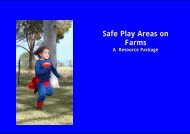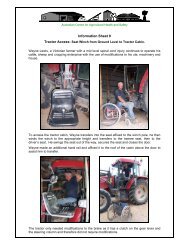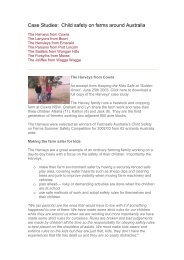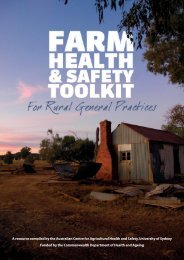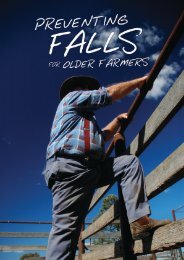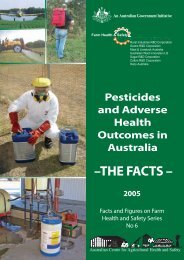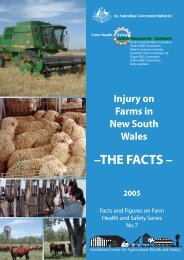Ripper ii Educational resource for primary schools - Australian ...
Ripper ii Educational resource for primary schools - Australian ...
Ripper ii Educational resource for primary schools - Australian ...
You also want an ePaper? Increase the reach of your titles
YUMPU automatically turns print PDFs into web optimized ePapers that Google loves.
TOPIC 4: RESPONDING TO INJURYOverview: Children map some of the consequences of injuries and develop background understanding of the need <strong>for</strong> safety interventionsexplored in following topics. Basic assessment and responses to minor vs. major injuries are introduced through farm-based examples.First-aid techniques are demonstrated and children practice these <strong>for</strong> common minor injuries.Teaching Strategies ACTIVITIES ResourcesActivity 1: CONSEQUENCES OF INJURYKeypoint: Injury can have serious consequences <strong>for</strong> both the person injured and their family.It is better to prevent injuries than to treat them after they occur.Discuss some of the impacts of an injury, using an example of a broken leg (eg. hospital, timeoff school, time off work <strong>for</strong> carers, lost income, stress on families, longterm disability).Newspaper reportKnowledge andunderstandingAnalysisSynthesisRead the newspaper clipping on the textsheet about an injury that has occurred on a farm.*Children can:• Share important elements of the story and discuss any thoughts, reactions to it.• Identify the hazard and the type of injury in the situation.• Find out what the personal consequences of this injury might have been?• Draw a “chain of consequence” <strong>for</strong> this incident <strong>for</strong> the boy and his family(eg. What disabilities / difficulties might the person have. Who would take care of them.How farm work and income might suffer. What this could mean).• Write a follow-up article to this story in your own words, Include in<strong>for</strong>mation on theconsequences of the injury and how it has effected his life and that of his family.News report*textsheetFarm injuryscenariosAnalysisEvaluationSynthesisActivity 2: FARM INJURY RESPONSESKeypoint: Children can determine if an injured person needs emergency help or not.The same steps can be taken in different situations.Divide the class into groups and give each group a scenario of different types of injuries*(ie. farm vehicles, machinery, animals, water, others). Children can:• Assess the situation – what happened, who was involved, where, when, how (contributing factors)• Discuss possible responses from a set of choices …(eg. 1. look out <strong>for</strong> danger, 2. decide if youneed help, (if yes, then…1. get help (how, who), …if no, then…basic first aid etc.)• Choose a course of action giving reasons why it is the best response• Each group presents their scenario and responses to the class• Complete the activity sheet on basic responses to an injury on farm/at homeFarm injuryscenarios*Activity sheet 3.4.1First-aiddemonstrationKnowledge andunderstandingPracticeskills / role playApplicationActivity 3: FIRST-AID SKILLSKeypoint: Children can develop and practice basic first aid skills <strong>for</strong> a variety of minor injurysituations. When unsure, children should always get help.Display a first-aid kit and the items inside. Discuss what each item might be used <strong>for</strong>.Demonstrate basic first-aid techniques <strong>for</strong>:• A minor cut - bleed• A painful / swollen joint / limb• A minor burn / scald• Someone tells you to go <strong>for</strong> help• Someone is not answering you (not responding)Discuss and describe instances where such injuries might occur at home / on a farm.Children can:• Practice / role play basic first aid techniques in pairs <strong>for</strong> the above situations• Suggest places where first-aid kits could be located / used49






